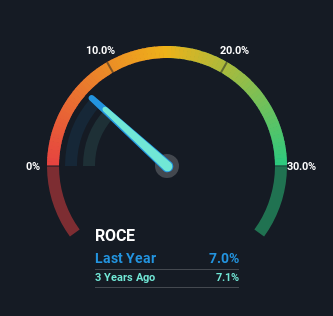- United Kingdom
- /
- Food and Staples Retail
- /
- LSE:SBRY
J Sainsbury (LON:SBRY) Hasn't Managed To Accelerate Its Returns

If we want to find a stock that could multiply over the long term, what are the underlying trends we should look for? Ideally, a business will show two trends; firstly a growing return on capital employed (ROCE) and secondly, an increasing amount of capital employed. Ultimately, this demonstrates that it's a business that is reinvesting profits at increasing rates of return. Although, when we looked at J Sainsbury (LON:SBRY), it didn't seem to tick all of these boxes.
Understanding Return On Capital Employed (ROCE)
For those that aren't sure what ROCE is, it measures the amount of pre-tax profits a company can generate from the capital employed in its business. The formula for this calculation on J Sainsbury is:
Return on Capital Employed = Earnings Before Interest and Tax (EBIT) ÷ (Total Assets - Current Liabilities)
0.07 = UK£1.0b ÷ (UK£26b - UK£12b) (Based on the trailing twelve months to September 2023).
Therefore, J Sainsbury has an ROCE of 7.0%. Ultimately, that's a low return and it under-performs the Consumer Retailing industry average of 16%.
See our latest analysis for J Sainsbury

Above you can see how the current ROCE for J Sainsbury compares to its prior returns on capital, but there's only so much you can tell from the past. If you'd like, you can check out the forecasts from the analysts covering J Sainsbury for free.
What Can We Tell From J Sainsbury's ROCE Trend?
There are better returns on capital out there than what we're seeing at J Sainsbury. Over the past five years, ROCE has remained relatively flat at around 7.0% and the business has deployed 23% more capital into its operations. Given the company has increased the amount of capital employed, it appears the investments that have been made simply don't provide a high return on capital.
On a side note, J Sainsbury's current liabilities are still rather high at 44% of total assets. This can bring about some risks because the company is basically operating with a rather large reliance on its suppliers or other sorts of short-term creditors. Ideally we'd like to see this reduce as that would mean fewer obligations bearing risks.
What We Can Learn From J Sainsbury's ROCE
Long story short, while J Sainsbury has been reinvesting its capital, the returns that it's generating haven't increased. Although the market must be expecting these trends to improve because the stock has gained 42% over the last five years. However, unless these underlying trends turn more positive, we wouldn't get our hopes up too high.
If you'd like to know more about J Sainsbury, we've spotted 3 warning signs, and 1 of them can't be ignored.
For those who like to invest in solid companies, check out this free list of companies with solid balance sheets and high returns on equity.
New: Manage All Your Stock Portfolios in One Place
We've created the ultimate portfolio companion for stock investors, and it's free.
• Connect an unlimited number of Portfolios and see your total in one currency
• Be alerted to new Warning Signs or Risks via email or mobile
• Track the Fair Value of your stocks
Have feedback on this article? Concerned about the content? Get in touch with us directly. Alternatively, email editorial-team (at) simplywallst.com.
This article by Simply Wall St is general in nature. We provide commentary based on historical data and analyst forecasts only using an unbiased methodology and our articles are not intended to be financial advice. It does not constitute a recommendation to buy or sell any stock, and does not take account of your objectives, or your financial situation. We aim to bring you long-term focused analysis driven by fundamental data. Note that our analysis may not factor in the latest price-sensitive company announcements or qualitative material. Simply Wall St has no position in any stocks mentioned.
About LSE:SBRY
J Sainsbury
Engages in the food, general merchandise and clothing retailing, and financial services activities in the United Kingdom and the Republic of Ireland.
Excellent balance sheet with proven track record.
Similar Companies
Market Insights
Community Narratives



